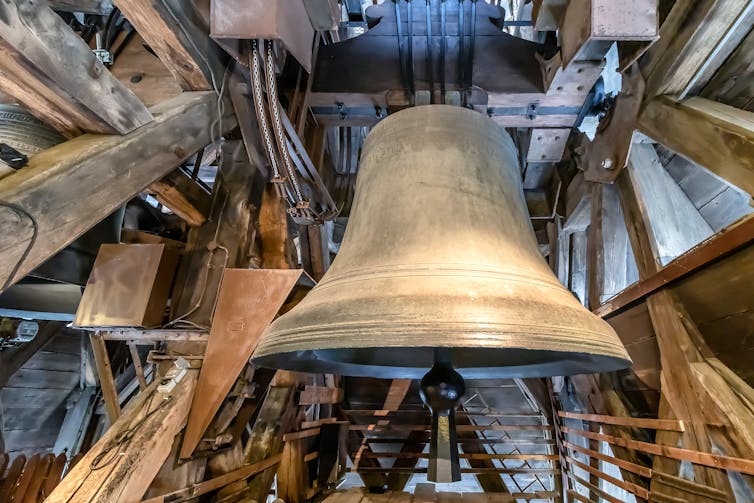Ahead of the reopening of Notre-Dame cathedral in Paris, eight of the cathedral’s church bells were before their re-installation in the north tower.
Philippe Jost, who has overseen the cathedral’s restoration following the devastating fire in 2019, described the as a “beautiful, important and symbolic step”. He called them the .
The sound of church bells has filled European landscapes for . And over that time, many cathedral fires have required a reinstallation of the bells.
In 1320, for example, the belltower of ŃÇÖŢÉ«°É Cathedral in north Wales burnt down. As a result, its from the yearly church tax.
Around the same time, the ŃÇÖŢÉ«°É Pontifical, a religious document of instructions and observances for the bishop, was created. It contains the only known medieval instructions for bell blessings in the UK.
Bell blessings, also known as the , vary slightly between religious denominations and countries. But anointing the outside and inside of the bells with oil, then lighting incense underneath them.
During bell blessings, the bells themselves can be named – usually after a saint – and sometimes given a corresponding inscription. The names chosen typically depended on who paid for the bell: if it was the local community, the bell was usually named after the saint the church was dedicated to, or a saint associated with the area.
This was the case at in West Smithfield, London. The treble, the smallest bell, was inscribed circa 1510 with Sancte Bartholemeo Ora Pro Nobis, meaning “Saint Bartholomew pray for us”.
A person or guild paying for a bell may pick a saint that reflects their career, life or private devotional practices. For example, a bell-ringer may dedicate a bell to , who is the patron saint of bell-ringers due to his early experimentation in forging bells at the turn of the 10th century.

Peals of protection
During the Middle Ages, it was believed that divine intervention could be requested by ringing a church bell, which would then benefit all who heard it. By naming a bell, people were requesting that specific saint’s intervention. In death, church bells would ring to from demons while their soul travelled to Purgatory.
During storms, bells associated with were believed to (the area in which the bells can be heard) from the evil spirits believed to cause bad weather and unrest.
Italian chronicler and archbishop of Genoa, Jacobus de Voragine, in 1230 in his book of saint biographies, :
The evil spirits that be in the region of the air, doubt much when they hear the trumpets of God which be the bells rung, and when they see the banners borne on high. And this is the cause why the bells be rung when it thundereth, and when great tempests and outrages of weather happen, to the end that the fiends and the evil spirits should be abashed and flee, and cease of the moving of tempests.
Thanks to their promise of divine intervention, supernatural protection from evil spirits and vital use for communication, church bells became central to life in the Middle Ages.
In 1552, the bishop of Worcester, Hugh Latimer, “if all the bells in England should be rung together at a certain hour, I think there would be almost no place, but some bells might be heard there”.
While not every inch of the countryside would have been covered with the sound of bells, a of a medieval village in Oxfordshire did find that the village boundary coincided almost exactly with the sound boundary of the church bells. This emphasises both the significance that medieval people placed on the aural protection of church bells, and the importance of the bells for communication.
It is no surprise that the Notre-Dame’s bells have been missed. With their powers of protection and communication, this step is a richly symbolic moment in the cathedral’s restoration.![]()





